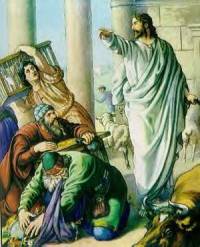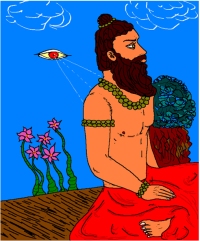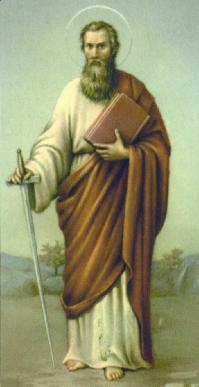 I am proud to deliver this lecture in the memory of a man I admire greatly without knowing him personally. I have not read everything Sri Sita Ram Goel has written, but I have read some of the most important things I have read anywhere, which I deem to have utmost significance for Hindus in these difficult times. I also found courage and inner certitude reflecting in his words, which qualities I consider as carriers of sincerity and truth.
I am proud to deliver this lecture in the memory of a man I admire greatly without knowing him personally. I have not read everything Sri Sita Ram Goel has written, but I have read some of the most important things I have read anywhere, which I deem to have utmost significance for Hindus in these difficult times. I also found courage and inner certitude reflecting in his words, which qualities I consider as carriers of sincerity and truth.
His sense of dharma made him distance himself from Hindu activists who apparently adopted shameful means to achieve their ends. His deep understanding of human nature enabled him to relate to members of other religious communities with the same compassion he had for his own, though he disagreed starkly with the  engines that propelled these religions. He looked at humanity without the coloured lens of religious ideologies, while dissecting these same ideologies into their absurd extremities. He stood for the unity of humans without categories that is envisaged in age-old Hindu tradition.
engines that propelled these religions. He looked at humanity without the coloured lens of religious ideologies, while dissecting these same ideologies into their absurd extremities. He stood for the unity of humans without categories that is envisaged in age-old Hindu tradition.
Sita Ram Goel’s insight into the conceptual underpinnings of Abrahamic religions without experiencing or undergoing any of them personally was tremendous. While researching for this lecture, I could miss Sri Goel’s book, Jesus Christ: An Artifice for Aggression only at my peril. The Appendix 4: Hindus vis-à-vis Jesus of the said book covers most of the important questions and answers pertaining to what Jesus Christ means for Hindus. I don’t want to go into those aspects here since they are already in the public domain. [1] - George Thundiparambil
 In understanding the claim of Jesus Christ to be both God and Saviour of mankind and to be simultaneously a historical person who walked this earth two thousand years ago, as described by the many gospels and other books of Christian literature, in the light of Sanatana Dharma, it is essential to first examine the conception of gods and goddesses and their general significance in phenomenal life from the Hindu point of view.
In understanding the claim of Jesus Christ to be both God and Saviour of mankind and to be simultaneously a historical person who walked this earth two thousand years ago, as described by the many gospels and other books of Christian literature, in the light of Sanatana Dharma, it is essential to first examine the conception of gods and goddesses and their general significance in phenomenal life from the Hindu point of view.
To start with, there is a big difference in the Christian and Hindu worldviews regarding Nature and phenomena. The Hindus are Nature worshippers [2] and consider human nature as divine, [3] whereas Christians hold Nature as evil and corrupt. [4] The Hindus consider humans as good and sinless from birth, whereas Christians consider all humans as naturally evil and sinners from birth. For this reason, Christians have a ritual called baptism to clean away the sin of human nature.
First of all, Hindu tradition does not recognize a God or Goddess as creator and controller of the universe. The Vedic devas and the Lord God of the bible who claims to have created the universe and rules over it, belong to different categories. The devas like Agni, Rudra, Maruts and Indra are all integral to phenomena. It means any one of the human species can relate to these devas. This distinction implies a direct verifiability of the devas on the part of any human individual. And the effort on the part of the Hindus has been to propitiate or receive a boon from these natural forces composed of the five elements.
Compared with the Hindu devas, the Lord God of the bible is external to phenomena. For this reason, we can come to know of the Lord God only through prophets selected by him. We cannot independently verify this god, because the Christian has to open his book and depend upon the hearsay of the prophets who were chosen by the Lord God to communicate with humankind.
Vedic devas, like all other gods and goddesses of all ancient peoples on earth, represented phenomenal forces, such as the five elements and their various aspects of power. The worship of the life-giving sun, Surya, was as ancient as humankind itself. The first hymn in the Rig-Veda is dedicated to the sun, which was perceived in both its aspects of the male and the female.
Even devas who came later, the most significant of them – Brahma, Vishnu, Maheswara – lofty philosophical concepts though they are, are all anchored in nature, which, I emphasize, is based on our phenomenal world. These devas represent the forces of creation, preservation and destruction that happen simultaneously every moment in our phenomenal existence. One of the most popular Hindu deities of today, Ganesha, is absolutely a deva anchored entirely in our phenomenal world. His pictorial depiction represents the five natural elements. [5] The avatars of Vishnu are illustrative of the different evolutionary stages of organic life and human consciousness.
It is pertinent to mention a much-quoted saying from the Rigveda which ostensibly attributes equal validity to all religions. By taking a line out of a stanza, people make a mountain out of a molehill. Thus, ekam sad viprãh bahudhã vadant actually is one of four lines that tell a different thing altogether. The line is applicable to the Vedic devas who are seen as aspects of the natural elements. This is a terrible mistake that has been pointed out by Sita Ram Goel. [6]
Who is Isvara then? The concept of Isvara as the ruler of several universes and everything in them, first appears in the Upanishads, a significant milestone in Hindu intellectual achievements. Ishavasya Upanishad states “ishavāsyam idam sarvam”, which means Isha dwells in everything, which in turn points to the phenomenal world. The Isvara concept was the product of millions of years of evolution and which is proposed after meticulous reasoning. Literally, Isvara only means “Lord” or “one who is richly endowed”. Gods become important for Hindus to succeed in phenomenal life. God is not sought by a Hindu for a good afterlife, but for the purposes and special circumstances of human life.
The relevance of Isvara for the Hindu comes from the concept of ishtadeva, which Sita Ram Goel calls “the highest symbol of a person’s spiritual aspiration.” [7] So if you worship a deva or devi as a tutelary deity, it denotes the personal and individual selection of a god or goddess as the highest symbol of your spiritual ambition. I shall come back to the principle of ishtadeva from a Christian point of view later.
The relevance of rational thought or the process of reasoning for Hindus is often underestimated. The foundation of modern science is the observation of phenomena and its propelling drive is reasoning or rational thought. It is exactly the same principle applied in jnānayoga, the philosophical faculty of the Hindu religion. This is the yoga for knowing brahman (ultimate reality) through jnana (knowledge) and is called brahmajnāna. All Hindu philosophies are included in jnānayoga and they strive to explain the ultimate reality through rational thinking. Intellectual Hindus who cannot identify with mystical paths of yogas can attain brahmajnāna or ultimate reality through rational thought. Jnānayoga is meant for such people.
The same principle of jnānayoga is applied here in the analysis of the Christian religion and its god. This means we are resorting to the process of reasoning to examine the verity of the Christian claim, which we find exactly contradicting the Hindu worldview. To be totally fair to the object of enquiry, we should clarify first of all what jnāna or knowledge means as defined by Hindu tradition.
Jnāna is the result of vichāra or reasoning on experience, says Adi Sankara in his work Aparokshanubhuti, Verse 11. To give a common example, the knowledge of the gravitational pull and shape of the earth as a globe is the result of reasoning on observations made by individuals. “All jnāna or knowledge is experience; but all anubhava or experience is not knowledge.” [8] The antonym of jnāna is ajnāna which is the absence of it and means ignorance. According to tradition, ignorance “represents that which is infinite, as finite, presents other things that are non-existent, and makes the Self appear as limited.” [9]
Hindu philosophy starts from the premise, the “I”, the Self that doesn’t require any proof for its own existence. [10] This is because it is assumed correctly that we cannot start applying reasoning on a non-existent thing. If we do, the result of such a reasoning would be faulty. Therefore, the starting point for any enquiry has been anubhava, the observation or experience of the Self, who is the witness.
On the contrary, Christian philosophy begins from Lord God whose existence is a product of hearsay and whose study is designated as “theology.” Simply put, these two systems of thought cannot be compared. The ancient philosophers, East or West, would reject a philosophy that is based on a premise that we cannot verify personally. The ancients never employed reasoning on unverified premises to generate a philosophy. Reasoning based on a priori principles is a mark of abstract sciences like mathematics, but for philosophy to be genuine, it should be based on what that is, or what that exists, which is the Self.
This differentiation between the Hindu and Christian viewpoints that exists like an invariable, endless thread is also reflected in the neutral dictionary definition of ‘religion’ as “the service and worship of God” and ‘God’ as “the Being perfect in power, wisdom, and goodness” (Merriam-Webster). For Hindus, the religion (“worship” of the “perfection of goodness”) is ‘dharma’, which is but the holding on to a set of defined and undefined code of ethics. For Christians, the religion is the “service and worship” of the biblical god, also called the god of Abraham, and holding on to his commandments.
 Dharma
Dharma
The notion of untranslatability of the term dharma was posited by the greatest expositor of dharma in history, Ved Vyasa, author of Mahabharata, millennia ago. [11] According to him, dharma is the substratum of everything [12]. Hindu tradition says dharma is bound to the atman just as heat is bound to fire, or fluidity to water. Dharma is the moral component in human consciousness.
We shall look at this term in the light of modern science. First, we will look at the etymological association the term dharma has with the term ‘god.’ Both these words are derived from the Sanskrit root word dhri, which means ‘that which holds.’ The term dharma derives straight from dhri. The Sanskrit word gadh also derives from the same root. It means ‘to hold fast’. From this word gadh, another word came to be – the German ‘gut’ and the English ‘good’ meaning ‘virtuous’, ‘right’, etc. Ultimately, from this qualitative noun arose the word ‘god.’ The two words, dharma and ‘god’ are also interlinked by the notion of ‘goodness’ (to which one holds fast). For Hindus, ‘god’ is bypassed by dharma. Following dharma is the pursuit of goodness and characterizes the worship of the perfection of goodness through personal behaviour.
When we examine dharma as defined by Vyasa – “the substratum of everything” – in the light of modern science, we have to look for it in the field of natural sciences. If the dharma of natural elements is the code of natural sciences, the substratum of human consciousness is encoded in genetics. Implicitly, this means Hindus believe dharma or the moral component in humanity is written into the DNA of beings. This also explains why Hindus consider Nature as divine and view humanity as good and virtuous by birth, in contrast to the Christians.
One of the most respected contemporary scientists, the evolutionary biologist Richard Dawkins, in his book The God Delusion suggests evidence for a universal moral grammar evolved over millions of years that crosses “geographical and cultural barriers and also, crucially, religious barriers”. [13] Dawkins formed this conclusion through his own observations and also those of Harvard biologist Marc Hauser who relied on psychological experiments and statistical surveys and by applying rational thought. This is jnāna, the knowledge that is obtained by applying rational thought to anubhava. These experiments also confirm Maharshi Vyasa’s statement of dharma being the substratum of everything.
 The Christian bible
The Christian bible
We now look at the claim of the Christian god in the light of what we have discussed so far. As said earlier, the Christian god reveals himself to us through select individuals who are generally termed prophets. The statements of the prophets are compiled in one book called the Christian bible and we get to know the Christian god through the pages of this book.
The Christian bible is said to be the most printed and most translated book in the world. This book has two parts, the first part being common to the Jews as well. The first part introduces us to the Lord God who is the protagonist. The second part, or New Testament, is exclusive to Christians and introduces us to Jesus of Nazareth, also known as Jesus Christ. The term “Christ” is the Greek translation of Hebrew “Messiah” which at that time meant “king” or “high priest.” Christians believe that the two gods are the same, but consider the latter as the son of the former when he took a human form on earth around 2000 years ago. Jesus is said to hold the record of being the most talked about and most discussed person of all personalities on earth, man or god.
It is reasonable to think that the person who cannot or does not reveal to everybody equally, naturally becomes the most talked about person of all, because he holds a mystery. This inability of the Christian god to reveal to everybody equally tells us that this god is beyond the ambit of our senses as well as our intellect. For people like the Hindus, who consider jnāna to be derived from anubhava of the Self, this kind of object of enquiry does not belong to jnānayoga, but is considered sruti, that which is heard or revealed. I am using the word sruti here in its general sense, because by Hindu tradition, this word is used strictly in terms of Hindu literature, the Vedas.
By convention the Hindu sruti is generally taken as truth without further investigation, especially when it is consistent with the system (ēkavākyata) and has been confirmed by respected commentators. This methodology is actually in use in the modern academic world, where students quote a respected and eminent scholar to reinforce or establish the truth of a matter. But according to Sankara, when sruti contradicts empirical knowledge, it is the sruti that has to be rejected. [14] So, when we are considering the Christian bible as legitimate sruti we have to apply the principles valid for jnānayoga as advised by Sankara.
This simply means we have to first examine the Christian book in the light of empirical methodologies and listen to what experts have to say about it before you decide on whether to accept the claim as legitimate or illegitimate. It also becomes pertinent to identify the protagonist of the book as to which category he belongs in the Hindu system, or whether he is outside the system. This is not a big task, because we can discern the nature of the Christian god from the bible by reading it ourselves and see whether this character really fits into any of the categories of divinity of the Hindus or whether it adds any new knowledge at all.
 The Old Testament and the Lord God
The Old Testament and the Lord God
Scholars are of the opinion that the Old Testament was written between the 8th and 6th centuries BCE and assumed its present form between the 5th and 3rd centuries BCE. The authorship of the first five books is attributed to Moses, a prophet with whom the protagonist Lord God made contact and gave the primary laws to be followed by his worshippers. These worshippers who abide by these rules and regulations came to be known as Jews in history. There are many other books that are appended to these five books to make up the Old Testament and differ in numbers according to the Christian denomination you follow, such as Catholic, Protestant, etc.
The Old Testament tells us that the Lord God created the universe and all that is in it in six days. Then he proceeded to make a man, Adam, in the image of himself and also a woman, Eve, from his rib and then prohibited them from eating the fruit of the tree of knowledge of good and bad. [15] The knowledge of good and bad is achieved through rational thought or reasoning and is called jnāna by Hindus. For the same reason, the believers of the book are required to suspend their rational thinking in order to consider whatever is said in these books. This system criterion is extended to the second part of the Christian bible, the New Testament, and is generally known as “faith” among the followers of this religion and is highly regarded. True Christians consider “faith” as superior to rational thought, even though the term is defined in the dictionary as “a belief without evidence.”
The reason given by Christians for the superiority of faith is that the Lord God intended it to be like that and it is said so in the bible. In the bible, however, the archetypal human pair opted in favour of rational thinking by eating the fruit of knowledge and were banished from the Lord God’s presence and condemned to death and evil. In the course of the story, this evil is inherited by the whole of humankind and their whole suffering arises from that.
After the creation episode and the play of power by the Lord God over humans, seen in the banishing of the human pair from Paradise, what becomes interesting in the narrative is the efforts of the Lord God to procure a set of people to worship him. For a dispassionate reader, it seems that the Lord God had to do a lot of difficult manoeuvres to emerge as a deity, which appears to have been much more difficult than creating the whole world. The Lord God finally succeeds when he confronts an old miserable man named Abram from a place called Ur in Babylonia, who had migrated to Haran, and promises him land and nations besides progeny if he were to worship him. Abram accepts an agreement with the Lord God, and gets a new name, Abraham. In return of worship, the Lord God grants the land of Canaan and all that is there to him. To make a long story short, by making this covenant, Abraham got land and progeny, and the Lord God got a set of people to worship him. The Jews, the Christians and the Muslims all swear by Abraham, when they want to distinguish this particular god and not to mix him up with somebody else.
The beginning of worship of the Lord God is significant historically, because it brought forth what is known as monotheism, which the dictionary defines as “the doctrine or belief that there is one God” (Merriam-Webster). From the narrative of the Old Testament, we apprehend the presence of a number of gods, even in the statements that explain the principle of one god [16] through the ten commandments. However, the followers of Abraham claim that there is only one god who is referred to as a male and all other gods and goddesses don’t exist or are false.
At this point, we may mention a recent archeological evidence referred to by a British biblical scholar, Francesca Stavrakopoulou, in her documentary film, The Bible’s Buried Secrets, Part 2, Did God have a Wife? She refers to archeological evidence that the Lord God of the Old Testament was originally a Canaanite god of war by the name of El and also had a female counterpart called Asherah. The point of significance is that before the Old Testament was written down after the 8th century BCE, the Israelites were a group of people in Canaan with the same kind of worship as other groups of people living in the area. Stavrakopoulou tells us that in the Old Testament the female counterpart of the god becomes not only insignificant, but becomes a mysterious person that needs to be put down.
The thought system that evolved out of this book and used by the followers of Abraham is called monotheistic theology. As stated, Christian theology starts from the god portrayed in this bible, a work of the prophets and their entourage, and not from a directly perceived object. However, Christians also claim that all goodness on earth comes from this god of the bible. Human nature is considered by Christians as entirely evil, in contrast to the viewpoint of Hindus. According to Christians, one needs to turn to “faith” to save oneself from this deplorable and terrible condition. In this context, ‘faith’ means a belief in the goodness of the Lord God and Jesus without any evidence. On the basis of this book, Christians believe that all goodness on earth comes from this biblical god. Without him, they say, we are all evil. For this reason, “faith” is good and “rational thought” is bad.
We will now examine what secular (faithless) scientists have to say about the character of the Lord God, which will be a significant factor in our assessment. In The God Delusion, Richard Dawkins starts his second chapter with these words: “The God of the Old Testament is arguably the most unpleasant character in all fiction: jealous and proud of it; a petty, unjust, unforgiving control-freak; a vindictive, bloodthirsty ethnic cleanser; a misogynistic, homophobic, racist, infanticidal, genocidal, filicidal, pestilential, megalomaniacal, sado-masochistic, capriciously malevolent bully.” [17] One who has read the bible dispassionately may find Dawkins strikingly articulate in his expression, evaluating the Lord God using the values of this age.
 The New Testament and Jesus
The New Testament and Jesus
The New Testament, also a collection of books about its protagonist Jesus, was written much later than the first part. The earliest of these books are estimated to have been written by second and third generation Christians in the latter half of the 1st century CE. They are deemed by scholars as records of the preaching of the earliest Christian missionaries. The collection as seen now was authorized in the 4th century CE by Christian leaders of that time to establish a certain common ground among the numerous versions of Christianity that existed at that time.
The first four books of this collection are called canonical gospels and were selected from around 60 such gospels [18] that circulated at that time. The rest of the books comprise the acts of the apostles, who were disciples of Jesus, while spreading Christianity, and the letters or epistles of Paul, a convert from Judaism who never met Jesus in his lifetime. Biblical scholars like Prof. G. A. Wells differentiate the character of the Jesus of the gospels and the Jesus depicted in the Pauline epistles. It is pointless here to go into the details that make up these differences, but suffice to say that all of them together make up the character of Jesus Christ as preached by many Christian professionals today. The gospels describe the extraordinary life of Jesus, while the remaining books build up a thought system from it, but together they make a connection to the thought system of the Old Testament and the Lord God.
According to the gospels, Jesus was born of a virgin and the Lord God of the Old Testament and brought up as the foster son of one Joseph. From the little we know of his biography, he became a preacher among the poor people of Judea, a part of today’s Israel, then a Roman colony. When he was not preaching, Jesus did many miracles, like raising the dead from their graves, enabling blind people to see and exorcising devils that possessed human beings of that time. He also did things that seem trivial and crazy [19], but these things were said to have been prophesied in the Old Testament as marks of the messiah / saviour for whom the Jews were waiting. He was prosecuted for blasphemy by the Jews because he called himself “son of god” and found guilty and crucified according to their laws and then buried. Then he is said to have resurrected from his death and escaped from his tomb. Later he appeared to his close followers and after giving many directions and advices for a few days, he disappeared.


 In understanding the claim of Jesus Christ to be both
In understanding the claim of Jesus Christ to be both 



1 comment:
Rajiv,
Do you have a link to the article if it's available on the web or can you post the references cited? There are quite a few of them. Thanks.
P
Post a Comment